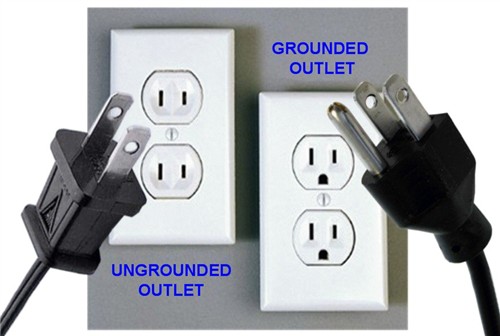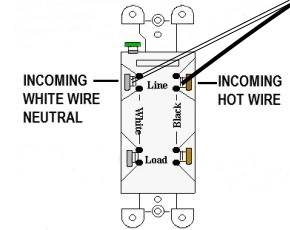Massachusetts Home Inspections YOUR INVESTMENT IS MY CONCERN

Ungrounded Outlets
Let's start off by distinguishing an ungrounded outlet from a grounded outlet.

Ungrounded outlets are easily recognized by their two-slot configuration, while newer grounded outlets feature two slots with a centered hole (the ground socket) beneath them. Throughout this article, I will refer to these as UNGROUNDED outlets and GROUNDED outlets.
Older wiring systems did not include a ground wire, so any ungrounded outlets in your home were originally installed this way and were deemed acceptable at the time. However, these outlets now pose safety risks. Many older homes still have ungrounded outlets, but as electrical standards have evolved, grounding is now required in newer homes. Although upgrading ungrounded outlets is not always mandatory today, it is strongly recommended. A properly wired home ensures a safer living environment for you and your family.
This is where the issues with ungrounded outlets start....
The challenges for owners of older homes arise when two-wire ungrounded outlets are replaced with grounded outlets, but the necessary rewiring to install a ground wire is not carried out. Homeowners frequently replace two-slot ungrounded outlets with grounded ones to accommodate their three-prong appliances. Since most modern appliance cords use three-prong plugs, homeowners with ungrounded systems often find it inconvenient to locate outlets that support these plugs. As a result, they may opt to replace the two-slot ungrounded outlets with grounded ones for convenience. However, without upgrading the entire branch circuit supplying power to the outlet, these new outlets remain ungrounded, thus continuing to present a safety hazard.
Grounded outlets should not be substituted for ungrounded outlets unless a new ground wire is installed. This requires a licensed electrician to run a new ground wire from the load center to the outlet. However, an exception to this rule is allowed by the National Electrical Code if the outlet is protected by a Ground Fault Circuit Interrupter (GFCI).
This brings us to... inexpensive fixes or upgrades
There are cost-effective solutions for homeowners who prefer not to rewire their entire house. One of the simplest and most affordable ways to address this issue is by installing a GFCI (Ground Fault Circuit Interrupter).
GFCIs can be installed in two different ways:
1.) A GFCI outlet can replace a standard ungrounded outlet, offering a safer alternative.
2.) A GFCI breaker can be installed at the load center, replacing the standard circuit breaker.
The National Electrical Code (N.E.C.) permits GFCIs to replace two-wire ungrounded outlets. However, this may not be the ideal solution, as the round grounding socket on a GFCI outlet could create the false impression that the outlet is properly grounded. To prevent confusion, it is recommended to clearly label these outlets as "NO EQUIPMENT GROUND."
A GFCI replacement for an ungrounded outlet is a good option when rewiring is costly or difficult. Instead of having an electrician run new wiring to install grounded outlets, you can use the GFCI function to provide personal protection at a more convenient outlet. While it doesn't provide the same level of safety as a fully grounded outlet, it is a significantly safer alternative in most situations. A GFCI outlet will trip (shut down) if it detects an imbalance in the current flowing through the neutral side of the electrical wiring. In the event of a ground fault, if current starts to flow into the casing (potentially toward you), a properly functioning GFCI will automatically trip, cutting off the current and preventing an electrical shock.
A GFCI upgrade should not be used when equipment is connected to a surge protector, such as for your computer. Surge protectors rely on the ground wire to safely redirect excess voltage during a surge. If a surge protector is plugged into an ungrounded outlet, it will not function as intended. In the event of a large surge or voltage spike, the surge protector needs a ground wire to redirect the excess voltage away from the protected equipment. Without a proper ground, the surge protector cannot protect your electronics, potentially causing damage. While surge protector manufacturers offer warranties, these are only valid if the surge protector is used in a properly grounded outlet.
How to Properly Replace an Ungrounded Outlet with a GFCI Outlet
Safety Always Comes First - If you're confident in your ability to replace the ungrounded outlets yourself, I will guide you through the process to complete the project correctly without hiring a licensed electrician. However, if you're not comfortable working with electricity or if multiple outlets need upgrading, I strongly recommend hiring a Massachusetts licensed electrician to handle the job. Your safety is always the highest priority.
✅ Before starting, ensure that the breaker (power) to the ungrounded outlet is turned off. Don’t rely solely on the markings on your service panel—double-check by plugging in a small appliance and turning it on to confirm that the power is off. Once you’ve verified that the power is off, begin by removing the screws from the outlet cover. Next, remove the screws securing the outlet to the junction box. Gently pull the outlet out and disconnect the two wires. You can dispose of the old outlet and cover, as the old two-prong outlet cover will not fit the new GFCI, which has a different shape.
✅ Take this opportunity to clean the receptacle box using a shop vacuum before installing the new GFCI outlet. Inspect the wires carefully and use electrical tape to cover any frayed or damaged sections. If the wires are significantly deteriorated, you may need to trim them or replace them with new wire.
✅ Next, confirm that there is enough space in the electrical box to accommodate the new GFCI outlet. Gently push the wires back into the box and perform a test fit with the new outlet. If the GFCI doesn't fit due to limited space or an excessive number of wires, a larger junction box will be required. In this case, it's best to have a licensed electrician install the appropriately sized box. Once everything fits properly, the electrician can complete the GFCI outlet installation.
✅ Begin the GFCI installation by using needle-nose pliers to bend the ends of the existing wires into a U-shape, allowing them to fit securely under each terminal screw. However, many newer GFCI outlets feature direct wire insert terminals, which eliminate the need to bend the wires. In these models, the wires simply slide into designated openings for a secure connection.
✅ Connect the black (hot) wire to the brass or gold screw, ensuring it is securely positioned beneath the screw head, then tighten the screw firmly. Next, attach the white (neutral) wire to the silver screw using the same method and tighten it. Since there is no ground wire at this location, the green grounding screw on the GFCI outlet will remain unused.
✅Gently fold the wires back into the electrical box and carefully push the GFCI outlet into position, making sure it sits flush with the box. Once properly aligned, secure the outlet by tightening the top and bottom mounting screws.

You should not have to force the outlet into place. If it doesn’t slide in easily, gently pull it back out, reorganize the wires, and try again. If you're still having difficulty fitting the wires into the box, you may need to carefully trim them to a shorter length. Forcing the outlet can damage the wires or cause them to disconnect from their terminals, potentially creating a safety hazard.
Remember: This outlet should always be clearly labeled "NO EQUIPMENT GROUND" to indicate that the ground connection is not present.
NOTE: If your goal is to provide GFCI protection for all ungrounded outlets in the home, it's not necessary to install a GFCI outlet at every location. Standard ungrounded outlets can be used, provided they are wired through the LOAD side of a GFCI outlet. However, since no ground wire will be present, these outlets must be clearly labeled "GFCI PROTECTED, NO EQUIPMENT GROUND."
NOTE: In many older homes, the outlet mounting box may be grounded back to the load center, even if the outlet itself is not. If this is the case, a jumper wire can be used to connect the grounded metal box to the grounding screw on the new grounded outlet. However, keep in mind that this type of grounding may not be sufficient for sensitive equipment or devices like surge protectors.
Here is what my clients have to say about my home inspection services:
Press F5 (on your keyboard) for additional testimonials
I recently accompanied David Valley during his inspection of the house my son was buying. Having purchased a number of houses during my lifetime, I considered myself very knowledgeable and thorough. However, he surpassed me greatly, picking up on important details I would have missed. He frequently suggested ways on how something could be fixed or improved. He displayed broad knowledge of house structure, heating and cooling system, plumbing, electrical, etc. David is the best home inspector I have ever employed and I recommend him implicitly. Thank you for a great home inspection.
Sincerely yours,
Hartmut S.














